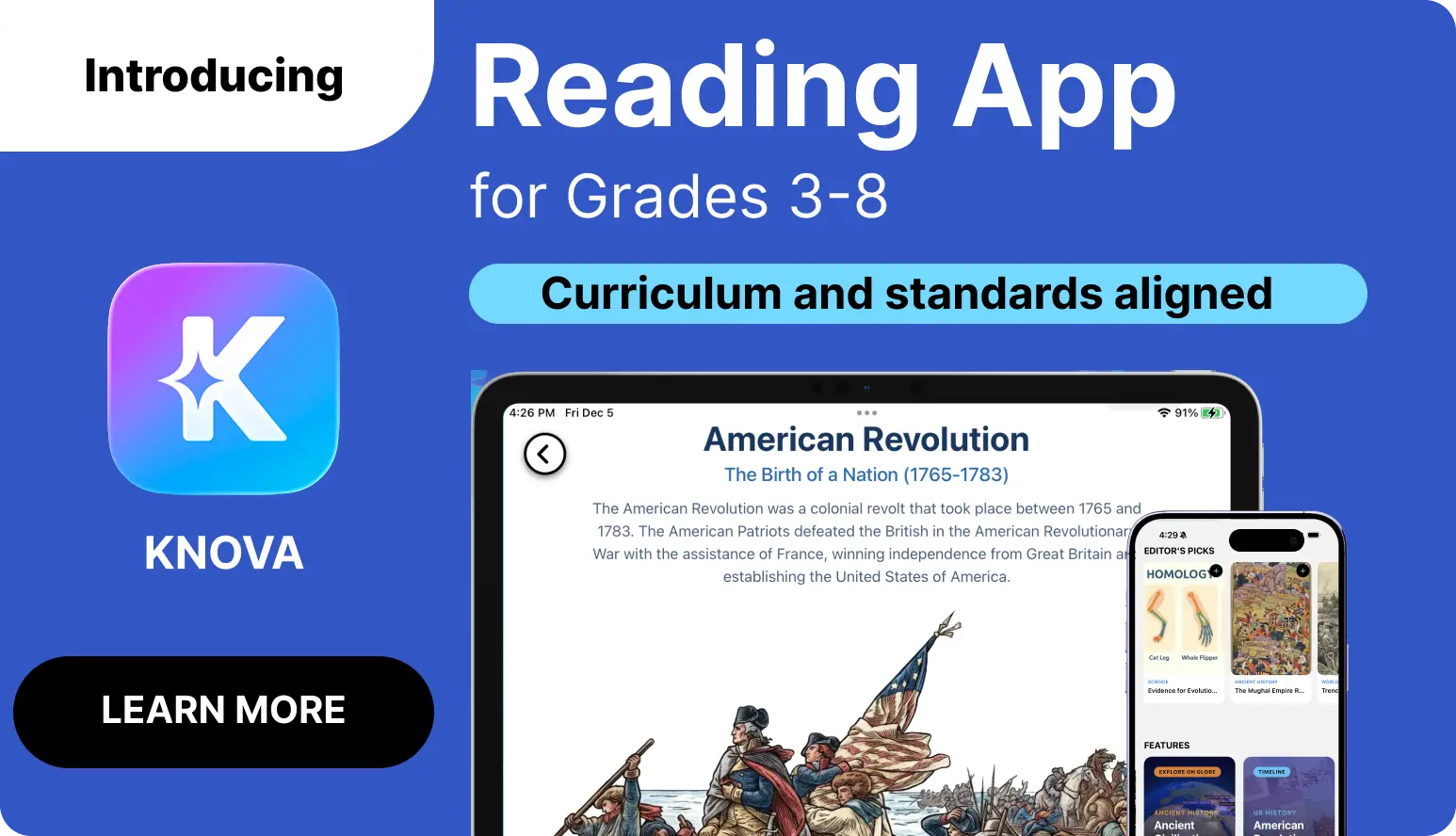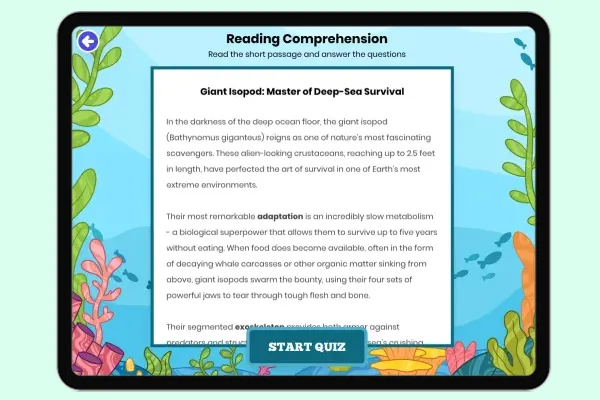Reading Results
The Solar System-Short Story
Join Mia on her science project journey through the solar system. Learn about the eight planets orbiting the Sun, their ...
RL.2.10RL.3.10RL.3.1RL.2.2
Natural Disaster: Tsunamis
Tsunamis are massive waves caused by underwater disturbances. Early warnings and evacuation plans are crucial to saving ...
RI.3.1RI.4.4RI.4.2RI.5.2
Natural Disaster: Landslides
Landslides occur when masses of rock or debris move down a slope. They can cause massive destruction and can be triggere...
RI.3.1RI.4.4RI.4.2RI.5.2
Kit Fox
The Kit Fox is a small yet agile desert animal known for its distinctive large ears and long, bushy tail. These ears not...
RI.3.1RI.4.4RI.4.8
GIla Monster
The Gila Monster is a large, venomous lizard found in desert regions. It has thick, bumpy skin that is orange and black,...
RI.2.1RI.3.1
Desert Scorpion Facts
The Desert Scorpion is a resilient arachnid that inhabits the desert. It has a hard exoskeleton for protection and uses ...
RI.2.1RI.3.2
How Do Turtles Move?
Turtles have evolved diverse locomotion methods to suit their varied habitats. Land-dwelling turtles, such as tortoises,...
RI.1.8
Different Types of Turtles
The world of turtles is incredibly diverse, with over 350 species showcasing a wide array of shapes, sizes, and adaptati...
RI.2.1RI.3.1
Turtle Sense of Hearing
Turtles possess a fascinating auditory system that, while different from mammals, is well-adapted to their unique lifest...
RI.2.1RI.3.5
What is a Starfish?
Starfish, also known as sea stars, are fascinating marine animals that captivate young learners. These unique echinoderm...
RI.1.1RI.1.2RI.1.8
Why Starfish are Important
Starfish play a crucial role in maintaining the delicate balance of marine ecosystems. As key predators, they help contr...
RI.1.1RI.1.2RI.1.8
The Blue Whale- Endangered Species
The blue whale is the largest animal on Earth, feeding on krill and found in oceans worldwide. Listed as endangered due ...
Furbish’s Lousewort- A Rare Flowering Plant
Furbish’s Lousewort is a rare flowering plant found only in Maine and New Brunswick. Discovered by botanist Kate Furbish...
The Principle of Island Biogeography
The Principle of Island Biogeography explains how island size and distance from the mainland affect species diversity. L...
7.RI.7.3
Silviculture: The Science of Forest Management
Silviculture is the science of growing and managing forests to meet goals like timber production, biodiversity, and carb...
7.RI.7.2
Runoff from Precipitation
Runoff from precipitation replenishes rivers and lakes but can cause flooding and pollution. Solutions like rain gardens...
RI.5.3RI.6.3RI.7.3
What is Transpiration
Transpiration is the process by which plants release water vapor into the atmosphere. It cools plants, contributes to hu...
RI.5.3RI.6.3RI.7.3
The Colorado River
The Colorado River stretches 1,450 miles from the Rocky Mountains to the Gulf of California. It carved the Grand Canyon ...
RI.5.5RI.6.9
The Mekong River
The Mekong River flows 2,700 miles through six countries in Southeast Asia, ending in the fertile Mekong Delta. It suppo...
RI.5.3RI.6.3RI.7.3
The Brahmaputra River
The Brahmaputra River originates in the Himalayas and flows 1,800 miles through China, India, and Bangladesh, joining th...
RI.5.3RI.6.3RI.7.3
The Amazon River Dolphin
The Amazon River dolphin, also known as the pink river dolphin or boto, is a unique freshwater species found in the Amaz...
RI.5.3RI.6.3RI.7.3
Rare Earth Minerals in Smartphones and Computers
Rare earth minerals are critical for smartphones, computers, and renewable energy. Mining them has environmental impacts...
RI.5.3RI.6.3RI.7.3
Understanding Biological Evolution and Diversity
This passage addresses the NGSS standard 3-LS4-2 focusing on biological evolution and the unity and diversity of life. T...
RI.3.3RI.4.3RI.5.33-LS4-2
Why Are Pollinators Important?
This passage explores the critical ecological role of pollinators in maintaining ecosystem stability and supporting huma...
MS-LS2-4RI.6.3RI.7.3RI.8.8
Why Are Honeybees Important?
This passage explores the essential ecological and agricultural roles of honeybees, supporting NGSS standard MS-LS2-4 on...
MS-LS2-4RI.6.3RI.7.3RI.8.8
The Narwhal: Arctic’s Unicorn of the Sea
This NGSS-aligned passage (MS-LS2-1) explores how narwhals survive in Arctic ecosystems. Students learn about specialize...
MS-LS2-1RI.6.3RI.7.3RI.8.8
The Fascinating Dumbo Octopus: Deep-Sea Wonder
Aligned to NGSS, this passage explores Dumbo octopus adaptations like ear-like fins for swimming at 3,000-13,000 ft dept...
MS-LS1-5RI.6.3RI.7.3RI.8.8
Venus Flytrap Facts
This passage explains where Venus flytraps live in North Carolina bogs, how their snap traps work, and their unique way ...
MS-LS1-4RI.6.3RI.7.3RI.8.8
Dumbo Octopus: Deep-Sea Survivor with Elephant Ears
This passage aligns with NGSS standard MS-LS2-4, investigating the Dumbo octopus's unique adaptations to deep-ocean envi...
MS-LS2-4RI.6.3RI.7.3RI.8.8
The Blue-Ringed Octopus
This NGSS aligned passage explores how the tiny blue-ringed octopus impacts its ecosystem through predator-prey relation...
MS-LS2-1RI.6.3RI.7.3RI.8.8
Pitcher Plants: Reproduction Facts
This passage describes tropical and North American pitcher plants, their liquid-filled traps, and how they get nutrients...
MS-LS1-4RI.6.3RI.7.3RI.8.8
The Giant Isopod: Biological Evolution
This NGSS passage examines how giant isopods evolved for deep-sea survival, including slow metabolism for food scarcity,...
MS-LS4-4RI.6.3RI.7.3RI.8.8
Tardigrades: Microscopic Superheroes
Aligned to MS-LS1-1, this passage examines how tardigrade cell structures (TDP proteins, DNA-repair enzymes) allow survi...
MS-LS2-1RI.6.3RI.7.3RI.8.8
The Dust Bowl Disaster
The Dust Bowl was an environmental disaster in the 1930s. Farmers had removed too much grass to plant crops. When drough...
MS-ESS3.CRI.6.1RI.7.4RI.8.2
Barreleye Fish: The Deep-Sea Telescope
This science passage explores the barreleye fish's extraordinary adaptations aligned with NGSS standard MS-LS2-4 (Ecosys...
MS-LS2-4RI.6.3RI.7.3RI.8.8
Giant Isopod: Master of Deep-Sea Survival
This NGSS-aligned passage (MS-LS2-4) examines the giant isopod's remarkable survival strategies in deep-sea ecosystems. ...
MS-LS2-4RI.6.3RI.7.3RI.8.8
Transform Plate Boundaries: Earth's Sliding Plates
This NGSS aligned nformational passage examines transform plate boundaries where tectonic plates slide horizontally past...
MS-ESS2-3RI.6.1RI.7.4RI.8.2
The Leafy Sea Dragon: Nature's Living Seaweed
This NGSS-aligned passage explores how leafy sea dragons (Phycodurus eques) demonstrate key life science concepts for mi...
MS-LS2-1RI.6.3RI.7.3RI.8.8
The Giant Squid: Ocean's Hidden Giant
Aligned to MS-LS4-2, this passage examines giant squid evolutionary adaptations like 10m tentacles, suction-cup hooks, a...
MS-LS4-2RI.6.3RI.7.3RI.8.8
Types of Plate Boundaries
This science passage explores how geologists use rock formations, fossil distributions, and seafloor structures to ident...
MS-ESS2-3RI.6.1RI.7.4RI.8.2
Anglerfish: The Deep-Sea Hunter with Bioluminescence
This passage aligns with NGSS standard MS-LS1-4 (Adaptations), investigating the anglerfish's extraordinary bioluminesce...
MS-LS2-4RI.6.3RI.7.3RI.8.8
Divergent Plate Boundary: Where Earth's Crust Pulls Apart
This science passage explains how divergent plate boundaries form where Earth's crust pulls apart, creating features lik...
MS-ESS2-3RI.6.1RI.7.4RI.8.2
Convergent Boundary: When Earth's Plates Collide
This science passage describes three types of convergent plate boundaries (oceanic-continental, oceanic-oceanic, contine...
MS-ESS2-3RI.6.1RI.7.4RI.8.2
Wolves of Yellowstone
This passage explores the ecological concept of trophic cascades through the landmark case study of wolf reintroduction ...
MS-LS2-4RI.6.3RI.7.3RI.8.8
Arctic Fox Facts: What Do Arctic Foxes Eat?
This passage explores the Arctic fox's dietary adaptations aligned with NGSS standard MS-LS2-4 (Ecosystem Interactions)....
MS-LS2-4RI.6.3RI.7.3RI.8.8
How Does Cryptobiosis work
This passage explains cryptobiosis, the process where organisms like tardigrades pause their metabolism to survive extre...
MS-LS1-3RI.6.3RI.7.3RI.8.8
Snow Leopard Adaptations
Snow leopards are master survivors of harsh mountain environments. This passage explores their specialized adaptations l...
MS-LS2-CRI.6.3RI.7.3RI.8.8
Early Life Forms and Their Adaptations
This educational passage focuses on early life forms and their basic adaptations, supporting NGSS standard 3-LS4-2 for e...
RI.3.3RI.4.3RI.5.33-LS4-2





















































